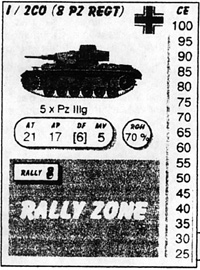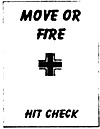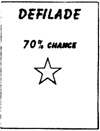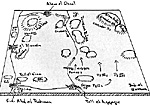My first Article detailing my WWII armor rules, Combat Team (CT), appeared in the December 96 PW Review. The article described a westem desert battle circa 1941 where we maneuvered and fired our tanks as units rather than individually as most modern armor rules dictate.
Not long afterward, Wally inquired about getting a copy for the PW gang to try. I hastily spiffed up my crude notes on computer, and sent them eastward. It is this version of the rules that Wally describes in the April and May 97 Review issues. Although greatly expanded from the set I used in 96, their experimental nature still showed.
Out here in Colorado Springs, my gaming friends and I continued to playtest and refine CT. In the Spring of 97, I set up new desert scenarios to test our improvements. They were loosely based on the first battles of El Alamein in 1941 (well before Monty arrived on the scene). After capturing Tobruk, Rommel pressed on eastward and tried to break through to Alexandria. Standing in his way were the British Commonwealth forces commanded by General Auchinleck.
Battlefield
March 15th -- the "Ides" of March; I set up the battlefield as shown below. If you compare this with a map of the real battlefield, you may notice I've compressed hundreds of square miles into a 6' x 6' tabletop area. "Guilty as Charged,- I plead, but all those nifty features make for a more colorful game even despite some of the tong~twisting village names.
We assigned victory points for taking and holding villages. The battle started with the Germans in possession of Sidi Abd el Rahman and Tell el Aqqaqir and the British holding Alam el Onsol and el Alamein. Each village was worth 10 points except for El Alamein which was 15. Thus the Germans had the incentive to attack,for maintaining the status quo meant defeat by 5 victory points. Both sides also had three command posts each worth 5 victory points if overrun.
 As noted earlier, CT groups playing pieces into units. Each unit has a status card. It shows all game-related information including movement, attack, and defense factors. Along the right side of the card is a Combat Effectiveness (CE) track. The player positions a paper clip on this track to indicate the unit's CE level. CE represents the overall morale and combat worthiness of the unit. When CE enters the red numbers, the unit bses its ability to fight and leaves the field.
As noted earlier, CT groups playing pieces into units. Each unit has a status card. It shows all game-related information including movement, attack, and defense factors. Along the right side of the card is a Combat Effectiveness (CE) track. The player positions a paper clip on this track to indicate the unit's CE level. CE represents the overall morale and combat worthiness of the unit. When CE enters the red numbers, the unit bses its ability to fight and leaves the field.
For instance, 1/2 Company of the 8th Panzer Regiment (shown at right) contains 5 Panzer IIIg tanks. A well trained unit, its CE must go all the way down to 30 before it breaks. Also note the "RGH" (rough terrain) percentage in the circle. This is an extension of Uncle Wally's "70% to cross rough terrain" rule. I've complicated it a little by giving each unit its own percentage value based on the type of stands in the unit. Vehicle RGH factors range from 60 to 80 percent, while most infantry have a 90 percent chance to cross rough terrain.
Since the version of the rules Wally played with, we further organized units into "formations." Generally, a formation consists of two to four units plus a "command post-. A command post is a single stand that doesn't really take part in the combat. Instead, it acts as an assembly point for units returning from the dreaded "Rally Zone" (more on this later) as well as a connecting point for units performing "Operational Movement" (more on this later too).
The Turn Sequence and Interdiction
A deck of tailored cards determines the sequence of actions in the game. Each card has one or more actions listed as well as who may perform the actions (Axis or Allies). The cards in the deck are shuffled and drawn one at a time with the players performing actions shown on each card as it is drawn.
For example, if the card drawn is an Axis Move or fire card, German and Italian units within each formation may move or fire. Normally a unit only acts once per card. But it may, if desired, perform one extra "fatiguing" action at a cost of a CE level.
Now here's the catch. Within each formation, the first action is a freebee. However, the second time any unit in the same formation acts there is a 10 percent chance of that unit being "interdicted" by the enemy. The third unit acting for each formation has a 20 percent chance of interdiction, and so on. Units taking fatiguing actions also add to this percentage. Being interdicted is a bad thing for a unit. First, it means that no further units in its parent formation may act on the current card. Second, the enemy may call down all sorts of nastiness on the interdicted unit -- from artillery barrages to ammo shortages.
These nasty things are determined by another deck of cards called, appropriately enough, the "Interdiction Deck.. At the beginning of the game, each side gets three cards for each formation it controls. The players may look at their cards and decide on one to play each time an enemy unit is interdicted.
Consider the case of the hapless Italians of the Ariete Division. Two companies of tanks and one company of 20mm "portee" guns advanced out of Tell el Aqqaqir. About halfway up the road to Alam el Onsol, they encountered British cruiser tanks dead ahead.
 When an Axis Move or Fire card came up, the first tank company fired at the cruisers scoring a few hits -- no problem here since it was the first unit in the Ariete formation acting, it had a 0% chance of interdiction. Then, the second tank company fired, missing the cruisers entirely -- the interdiction level rose to 10%. I rolled a ten-sided die and got a 5 -- no interdiction. Not satisfied with the results of my attacks, I decided to have the first company take a fatiguing action and fire again, the interdiction level rose to 20%. The brave Italian tankers scored yet more hits on the Brits, but when I rolled for interdiction, I got a 2 -- thus ending the Italian formation's actions for this card. To add to misery, Joe Lusk, playing the part of General Auchinleck, played an "Out of Petrol" card on my first tank company forcing them to remain stationary for the rest of the card deck.
When an Axis Move or Fire card came up, the first tank company fired at the cruisers scoring a few hits -- no problem here since it was the first unit in the Ariete formation acting, it had a 0% chance of interdiction. Then, the second tank company fired, missing the cruisers entirely -- the interdiction level rose to 10%. I rolled a ten-sided die and got a 5 -- no interdiction. Not satisfied with the results of my attacks, I decided to have the first company take a fatiguing action and fire again, the interdiction level rose to 20%. The brave Italian tankers scored yet more hits on the Brits, but when I rolled for interdiction, I got a 2 -- thus ending the Italian formation's actions for this card. To add to misery, Joe Lusk, playing the part of General Auchinleck, played an "Out of Petrol" card on my first tank company forcing them to remain stationary for the rest of the card deck.
On a later move or fire card, the same thing happened to the second tank company, I failed the interdiction roll, and Joe played another "Out of Petrol" card on them. Two thirds of my Italian force was stuck in the middle of the battlefield unable to move. British tanks quickly outflanked them and pummelled them into the sand!
Weapons Fire
As Wally has mentioned in his articles, Combat Team stipulates that weapons fire by unit rather than individual tank or infantry stand. The German 33rd AA battery, for example. fired at a unit of British Matilda tanks some 30 inches away near El Alamein. The unit's three fearsome 88mm guns had an anti-tank hctor of 49. From this, I had to subtract the range in inches over ten (20) and the Matilda's armor factor (12) leaving an aKack number of 17. To this I added a percentage dice roll to get an attack total. I rolled a 51, so adding 17 gave me a total of 68. I then referenced the table below for the result:
-
Attack Total 101+: 1 kill, plus 1 hit for each firing stand in unit
Attack Total 91-100: 1 hit for each firing stand in unit
Attack Total 51-90: 1 hit each for HALF of the firing stands in the unit
Attack Total 01-50: No hits
Since 68 is between 50 and 90, half of the guns in the 33rd battery scored hits. The unit had 3 guns so 1.5 hits were scored (1 hit plus a 50% chance of a second). I rolled under the required 50%, so the 88's inflicted two hits. The owner of the target unit, Alex Ching, then had the option of distributing the two hits to whichever Matildas he desired as long as he distributed the hits as evenly as possible. Any individual vehicle receiving a hit that didn't have its front facing the firing unit was deemed to be flanked and had the hit doubled.
For each hit, the unit test one CE level. After several rounds of 88mm fire, Alex's Matilda unit became bruised and bloodied.
Those who read the PW Review regularly will note that I've simply taken one of Uncle Wally's favorite attack results tables and modified it to take into account the number of stands firing. This feature allows players to attack with units rather than individual tanks, yet still provides results that ace count for every gun firing -- a great time savings with little or no ioss in detail.
Certain cards had an additional notation at the bottomthat said, "Hit Check". After the main actions for that card were complete, the side indicated had to roll percentage dice for each stand with hit markers on it. A stand's chance to pass a hit check equalled its parent unit's CE level minus 5% for each hit marker it had. If it rolled equal to or less than this number, all hits were removed. If it rolled higher, the stand went to the Rally Zone shown on its unit card to await its ultimate fate.
Defilade
 Another type of card in the turn sequence deck is the "Defilade" card. Each of these shows a
percentage chance to find cover in the open; either 30, 50, or 70 percent. This base percentage may be modified for terrain, so, for instance, being in a village may add 20% to a unit's base chance of going defilade. If the unit later moves at any time, it ioses its defilade.
Another type of card in the turn sequence deck is the "Defilade" card. Each of these shows a
percentage chance to find cover in the open; either 30, 50, or 70 percent. This base percentage may be modified for terrain, so, for instance, being in a village may add 20% to a unit's base chance of going defilade. If the unit later moves at any time, it ioses its defilade.
I've found this discrete method of determining who's in cover and who's not to be very effective. The die roll tells all. Also note that with this method it's possible for a unit to be in an exposed position even though it's in potentially protective terrain. Until it makes its defilade roll, it hasn't found cover yet. Once a unit gains defilade, the number of hits from any attack is halved. So, if an enemy attack results in 4 hits, the defiladed unit only takes 2.
In the version of CT Wally played, interdiction alone wasn't quite enough to balance the randomness of the card draw turn sequence. Inevitably, one side would draw several cards in a row and act with unit after unit without getting interdicted.
In the newer version of the rules, we deem defiladed units to be in good "overwatch" positions. This means they can attempt opportunity fire during enemy actions. Each unit attempting opportunity fire sacrifices one CE level in order to add 10 percent to an enemy unit's chance of interdiction. If the enemy unit is Interdicted, then any of your units attempting opportunity fire get to make an attack in addition to the play of the interdiction card. If you have enough defiladed units with a line of sight to a unit, you can make its life rough indeed.
This is what happened on my right flank with the units of the 15th Panzer Division. As I moved up my panzers in what I thought would be a brilliant flanking maneuver, Joe went defilade with his Crusader tanks on and around Alam Halfa Ridge. While rny shots bounced harmlessly into the sand around his Crusaders, Joe's retum fire began taking a toll of my tanks. As I closed on his positions, he used the opportunity fire rule to up the odds of interdiction. Suddenly, half my panzers were "Out of Ammo. and taking close range 2 pounder fire.
The End of Turn Card
One card in the sequence deck was labelled "End of Turn." When we drew this card, the deck was reshuffled and we went through an end of turn phase. Thus, one run through the deck of cards -- a single turn (or bound as Wally would call it) would vary in length unpredictably.
While the other action cards represent a few seconds to at most an hour, the End of Turn card represents several hours in time. Thus, at the end of each card deck, the game shifts from a tactical to a more operational perspective.
The card lists three procedures to go through: Rally Zone Checks, Operational Moves, and Hit Checks. During the first two activities, the command posts come into play.
Consider the 1/ 2 Company of the 8th Panzer Regiment. Three of its five tanks went to the rally zone during the second bound. When the End of Turn card came up, I rolled a ten-sided die for each tank hoping to get at or under the unit's rally number of 8. Two tanks survived, one didn't. The tank that failed, we deemed destroyed, while the other two panzers reappeared on the field next to 8 Panzer Regiment's command post.
After Rally Zone checks, we could make operational moves. When performing operational movement, a unit ignores terrain and distance. The only things that matter are its starting point and its destination. A unit in the field could move to a command post. A unit at a command post, or for that matter a command post itself, could move to either another command post or a unit in the field. Thus, the two wayward panzers of the 2nd company "op-rnoved" to rejoined their unit in the field.
Operational movement fell under the same fatique and interdiction rules as normal movement, so you had the option of pushing your units as far as you dared. You might have noticed by now that a lot of CT's procedures balance gain with risk. You can push troops harder by sacrificing CE; you can act with more units at the risk of being interdicted; and so on.
Alas, at First Alamein, I pushed my troops too far and took too many risks. The Commonwealth forces of Alex Ching and Joe Lusk prevailed. But I tallied the battle a great success. We fought a battle with over 100 tanks and infantry stands to conclusion in about 3 hours!
Battle the Second
Corne April, we were at it again. This time my old friend, John Anton, joined us and deftly took on the roll of General Rommel. I contented myself with playing his Italian assistant, General Atsamore.
Whereas in the previous battle, I had maneuvered the panzer forces in a wide flanking maneuver through the desert area to the south. John cleverly attacked with his panzers along Ruweisat Ridge. His tanks took advantage of the increased chance to gain defilade (hills added 10 percent to the percentage needed) while they kicked all British forces off the ridge. In this vicious thrust up the center of the battle field, John's tanks ran into an ambush.
For some time I had deliberated on how to best represent hiding and spotting in the rules. Finally, I hit upon the idea of making it all an extension of the "defilade" concept. During operational movemeet, any previously defiladed unit could attempt to "camouflage" its position. It did this by rolling percentage dice less than or equal to its current CE level. Camoufiaged units couldn't be fired at until they revealed their position by moving or firing, or they were spotted by an enemy unit.
On several of the action cards, I added a note at the bottom which said something like "SPOT 25% (50%)". The firing percentage was used for spotting beyond 10 inches range while the one in parentheses gave a doubted chance to spot targets at 10 inches or less.
John's panzers engaged the camouflaged British tanks once they had fired a salvo. The Afrika Korp's marksmanship proved superior and the panzers pushed on into Alam el Onsol. Alas, the offensiw proved too costly. Alex and Joe had kept some tanks in reserve, and these concentrated fire on John's remaining tanks destroying them all.
In the meantime, General Atsamore' launched an attack directly toward el Alamein in an effort to regain the advantage. Alex's carefully placed Honey tanks decimated the Italian ranks and then counterattacked with Infantry capturing the town of Abd el Rahman. With our forces smashed and the Brits on the offensive, John and I decided to call it a day.
Final Thoughts
The balance of unpredictibility and risk taking in the two Alamein games seemed to be a winning combination. At least everyone said they had fun.
By far the most successful aspect of these rules is the departure from stand-by-stand action in favor of unit-based action. As commanders, the players worry about ordering units around, while the rapid game mechanics still allow them to see what happens to individual tank and infantry tokens.
To give credit where credit is due, most of the rubs systems in CT have their basis in Wally's ideas. I've used card draw turn sequences ever since reading his articles in Wargamer's Digest back in the 70s. The attack results chart comes straight from the pages of the PW Review. The "Rally Zone" is another Simon original not to mention the percentage roll to cross rough terrain, and the list goes on. . .
Often one side gets several action cards in a row, forcing the other side to wait with nothing to do. In the Alamein games, the interdiction and opportunity fire rules didn't go far enough to remedy this. In a more recent game, we allowed defiladed units to spend a CE level to op-fire at acting enemy units within line of sight (as opposed to just influencing the interdiction level). This change pretty much eliminated the problems caused by the random turn sequence.
Anyone interested in Combat Team can contact me via email at DeltaVee1@aol.com.

Back to PW Review January 1998 Table of Contents
Back to PW Review List of Issues
Back to MagWeb Master Magazine List
© Copyright 1997 Wally Simon
This article appears in MagWeb (Magazine Web) on the Internet World Wide Web.
Other military history articles and gaming articles are available at http://www.magweb.com